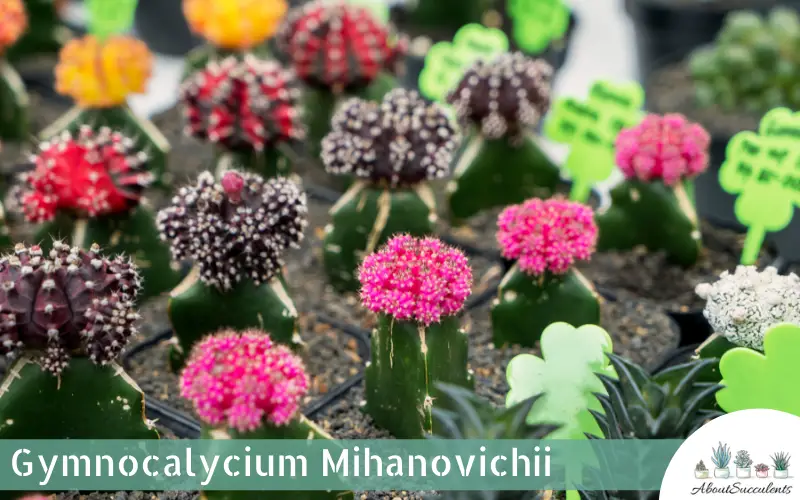
The alluring Gymnocalycium mihanovichii is actually made of two cacti, the Gymnocalycium and the Hylocereus. The Gymnocalycium is also called the Ruby Red Cactus and is grafted on top of the succulent.
The rootstock cactus or the one at the bottom could be any variety of cacti that is tall enough to draw more attention to the Gymnocalycium. The term Gymnocalycium is descriptive of the flower buds which don’t have spines or hair.
The fascinating yet, intriguing appearance of the succulent has spawned a few amusing names for Gymnocalycium mihanovichii such as Moon Cactus, Ruby Red Cactus, Ruby Ball Cactus, and Mutant Cactus.
The plant got the name “Moon Cactus” for its yellow and orange varieties. The lack of chlorophyll gives the globe unique colors that include variants with red, white, and pink flowers.
It is referred to as a mutant plant because Gymnocalycium mihanovichii cannot survive without a host. The Gymnocalycium has to be grafted onto a rootstock cactus which becomes the food source in the absence of chlorophyll.
Gymnocalycium mihanovichii can reach a height of 12-inches (30.5cm). The succulent plant originates from the Cactaceae family and is native to Chaco Boreal in Paraguay.
General Information:
Also known as: Moon Cactus, Ruby Red Cactus, Ruby Ball Cactus, and Mutant Cactus
Plant Family: Cactaceae
Origin: Chaco Boreal in Paraguay
Height: 12-inches (30.5cm) tall
Exposure: Partial to light sunlight
Water Needs: Water only when soil is dry to the touch, little watering during the winter months.
Soil Type: Commercially available potting soil for succulents or cactus soil plus 25% to 50% perlite or pumice to improve drainage
Soil pH: Neutral (5.1 to 5.5 pH)
Tolerance: Drought
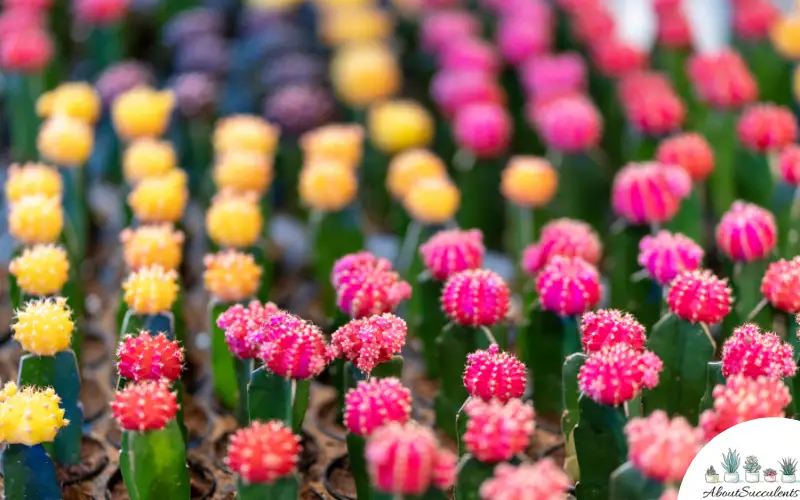
How to Grow and Care for Gymnocalycium Mihanovichii
Gymnocalycium mihanovichii is one of the easiest succulents to grow. It can be grown indoors and is popularly used as a window garden ornament.
1. Sunlight
Moon Cactus has an interesting relationship with sunlight. The ruby-red ball on top prefers the shade and does not like direct exposure to the sun. The rootstock cactus thrives with more sunlight.
You have to find balance in the amount of sunlight the succulent receives. Too much or too little and the colors of the Gymnocalycium may fade.
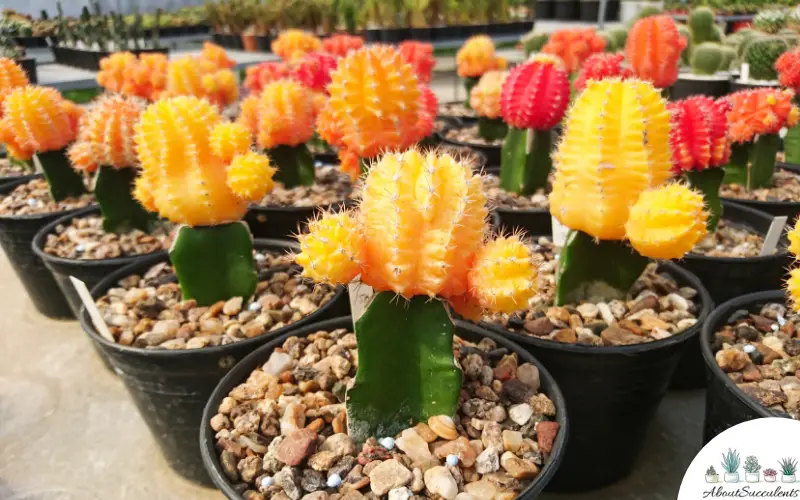
The best arrangement is to place Moon Cactus in an area in the garden that receives partial to light sun. If grown indoors, place the plant in a location that receives filtered sunlight.
This is not a cold-hardy succulent. If you are in a region where the temperatures can drop below 30° F (-1.1° C), it would be strongly advised to grow Moon Cactus indoors.
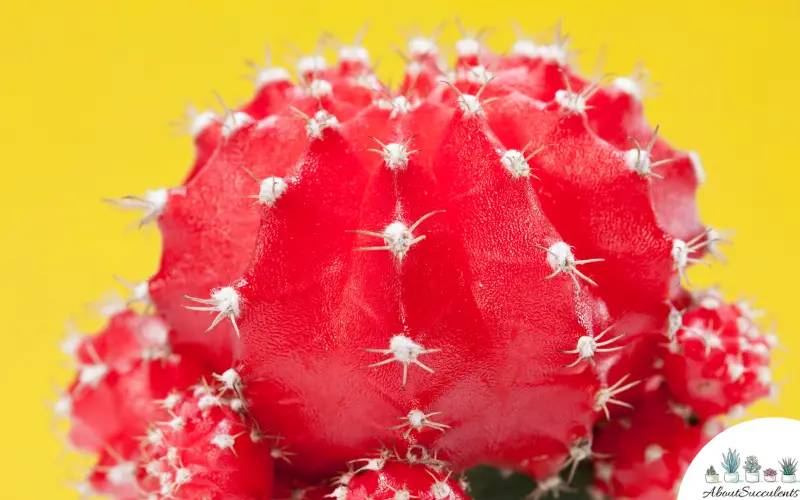
2. Watering
Gymnocalycium mihanovichii exhibits the same watering needs of succulent plants.
Before giving the plant water, check the moisture level of the soil. If the soil is dry to the touch, give it a good amount of water.
Do not let Moon Cactus sit in water for more than one day. If your pot has a tray, empty its contents of water. If the roots stay immersed in a moist environment, it will rot and contaminate the entire succulent.
Frequent watering will be needed during the spring and summer months but not in the winter.
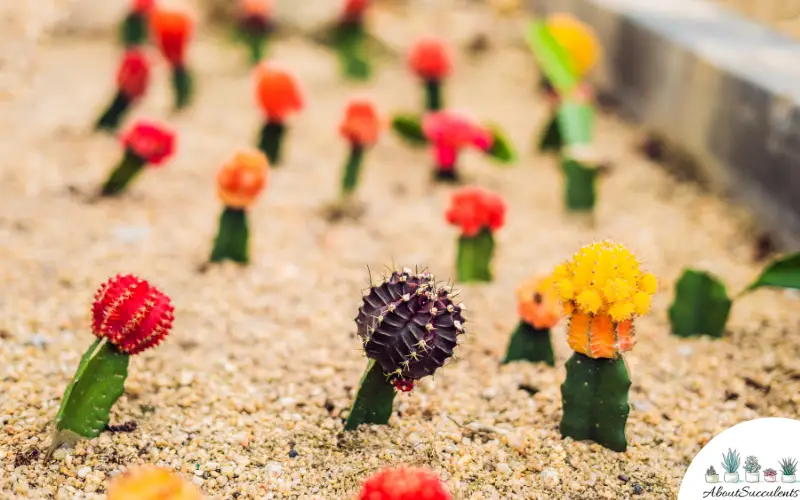
3. Pot and Soil
Plant Gymnocalycium mihanovichii in a pot that has good drainage. It is recommended to use a ceramic pot instead of a plastic one because it allows better evaporation of excess moisture.
Moon Cactus can grow well in commercially available potting soil for succulents or cactus soil. You can also add 25% to 50% perlite or pumice to improve drainage.
The Gymnocalycium mihanovichii succulent plant does not need to be given fertilizer.
How to Propagate Gymnocalycium Mihanovichii
Gymnocalycium mihanovichii can only be propagated through the use of offsets. The small-sized offsets will appear at the top of the succulent.
Step 1 – Carefully remove the offsets from the top of the plant.
Step 2 – Allow the offsets to harden and develop calluses by leaving them in a dry place.
Step 3 – Once the offsets have hardened, place them on well-draining soil.
Step 4 – Water the soil if it feels dry to the touch.
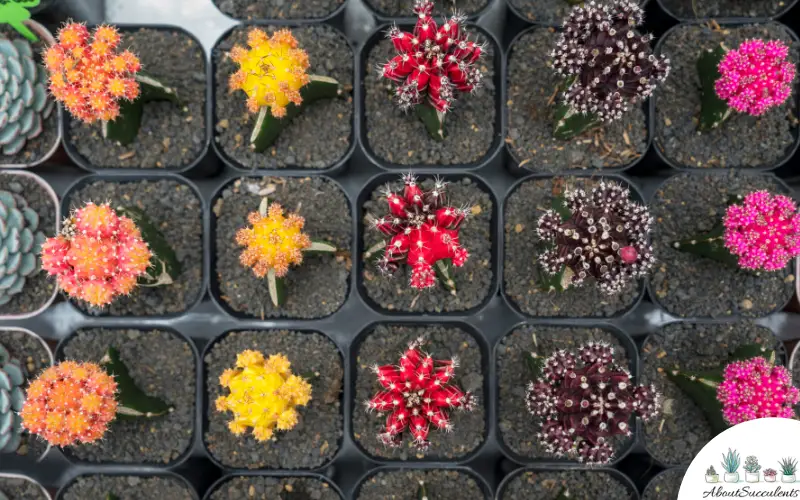
Unfortunately, not all Moon Cactus will produce offsets. Thus, Gymnocalycium mihanovichii can be quite difficult to propagate. It may be better to learn how to re-graft the Gymnocalycium onto a new rootstock.
To re-graft Moon Cactus, follow these steps:
Step 1 – Use a sharpened and sterilized knife to cut the top of the plant’s seedling columnar cactus.
Step 2 – Cut the scion from the rootstock.
Step 3 – Press the plants together so that the circles of vascular tissue found at the center of the stems of the scion and new rootstock are partially aligned.
Step 4 – Use rubber bands to hold the plants until the tissues grow together.
Frequently Asked Questions
Is Gymnocalycium Mihanovichii Toxic for Cats and Dogs?
Gymnocalycium mihanovichii does not appear in the list of plants that are toxic to cats and dogs on the website of the American Society for the Prevention of Cruelty to Animals (ASPCA).
Keep in mind that the list presented on the website is not complete and does not cover all succulent plants.
If your pet ingests Moon Cactus and exhibits symptoms such as vomiting and gastrointestinal distress, proceed to the Veterinarian right away.
Why is my Gymnocalyciu, Mihanovichii Succulent Dying?
If your Gymnocalycium mihanovichii succulent is getting weaker or perhaps dying, there are 2 possible causes: Overwatering and pest infestation.
1. Overwatering
Moon Cactus is susceptible to overwatering which leads to root rot. A clear sign of root rot is discoloration. For Gymnocalycium mihanovichii, growers refer to discoloration as black neck rot.
If you suspect root rot, the best solution is to re-pot the succulent.
Gently remove Moon Cactus from the soil. Shake off excess soil, cut off the rotting roots, and allow the plant to dry out completely.
Re-plant the succulent in a ceramic pot with fresh, well-draining potting soil.
2. Pest Infestation
Gymnocalycium mihanovichii attracts mealybugs and scale insects. If a plant is infested with these pests, it will wither and die because the insects will drain it of nutritious sap.
Spray Moon Cactus with a mild insecticide and remove the insects with tweezers. Mealybugs will leave white, cotton-like substances on the plant. You can wipe these substances off by using a cotton ball that has been soaked in denatured alcohol.
Does Gymnocalycium Mihanovichii Produce Flowers?
Gymnocalycium mihanovichii hardly produces flowers. But if they do, the flowers are small, colored pink, and grow from the sides of the plant. The flowers do not have a scent.
Last Updated on June 10, 2022 by Sofia Lara